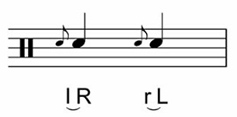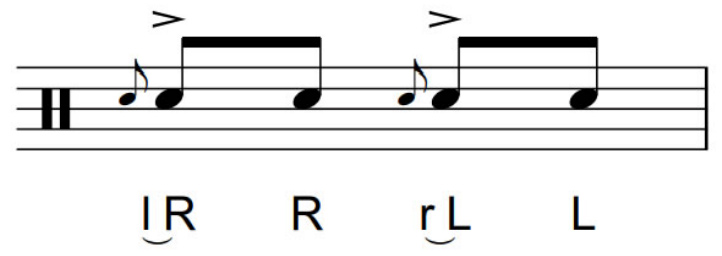FLAM RUDIMENTS
Flam
The Flam is a major staple in your drumming tool box, it gives you another flavor to add into fills, makes single snare or tom hits much more powerful and opens up another level of depth to your rudiments. Flams are simple one stroke followed quickly by another, so they sound almost on top of each other in time. This timing can be difficult to master, so take a listen to the video below to hear how they sound.
Another note: A flam that it played l_R is referred to as a R handed flam. This may seem odd, given the left comes first, but it's because the R hand is the main note. So remember, whichever hand plays the main (larger) note, is the way it will be referred to.
Right Handed Flam: l_R
Left Handed Flam: r_L
Practice keeping the flam hand low and the main note high. This may be challenging, but will ultimately give you more control and help you know which direction your flam went, R or L handed.
Flam Accent
The Flam Accent is a triplet based flam rudiment, putting a flam on the beginning of each triplet. Triplets can be hard to play because they are an odd grouping of notes which means the lead hand will change each repatition. Start off this rudiment (and all flam rudiments) playing it without the flam focusing on accenting the beginning of each group of 3. After you've mastered that add the flam in, being conscious to get the correct direction of the flam. Practice slow and make sure your sticking is perfect before speeding up!
Flam Tap
The Flam Tap is played just like how the name sounds. You'll flam and then tap the hand that played the main note. So for example if you played a right handed flam, you'd tap your right hand, then a left handed flam and tap your left. Think about this like the main hand just has a little extra momentum and is coming down for one more stroke. This visualization can help you remember to play the correct hand after the flam.
Flamacue
The Flamacue is an interesting rudiment in several ways: It uses an unaccented flam at both the beginning and the end of the pattern, and also uses an accent coming out of a flam, which can be tricky to nail. Spend time playing this rudiment very slowly, getting the flam to stay low and getting a strong accent after. These points are what makes this rudiment, so don't overlook them!
Flam Paradiddle
The Flam Paradiddle is simply adding a flam on the first note of a paradiddle. This is an easy rudiment to understand conceptually, but can be difficult like all flam rudiments to play with the correct direction of the flam. Spend time playing it slowly, and if your paradiddles are strong, this should come fairly easy to you.
Single Flammed Mill
The Single Flammed Mill is kind of like a reverse paradiddle with a flam on the front end: You double and then alternate (RR LR). Once you have this down, add a flam to mark the beginning of the pattern.
Flam Paradiddle-Diddle
The Flam Paradiddle-Diddle adds a flam on the beginning of the single flam paradiddle you learned previously. The biggest difference from the non-flam version, is that you will alternate which hand leads. This will feel like you have a triple stroke as you end one pattern and begin the next, so take your time!
Pataflafla
The Pataflafla, what a name.... In all seriousness, the pataflafla is built from a single stroke roll, adding a flam on the beginning and end. You can think about this like having a group of four notes where the 1st and 4th each have a flam. What makes this tricky is having two flams next to each other, and on different hands. Be extra conscious to get the flam in the right direction, as that is the most important aspect of this rudiment.
Swiss Army Triplet
The Swiss Army Triplet is a really interesting way to play a group of 3 notes and is used in fills frequently. Start by playing a double followed by a single, and get use to how this feels (RR L). Then once you're comfortable, add a flam to the first note. It's kind of like taking a flam tap and adding an extra tap afterwards on the other hand.
Inverted Flam Tap
The Inverted Flam Tap is just like the name sounds, it's the opposite of the tradition flam tap rudiment. Once you've played a flam, instead of playing the same hand as the main note, you play the opposite. This feels very strange and quickly will make your hands feel twisted. Take time to play this very slowly, and practice it along side the flam tap to feel the difference between the two patterns.
Flam Drag
The Flam Drag is also just like the name sounds and bridges us to the next set of rudiments. You'll play a flam, followed by a drag. This rudiment is another triplet based rudiment, so it will give you a jazz/swing feel. You'll learn more about drags in the next section, so look ahead and come back to this rudiment once you feel comfortable with drags.











